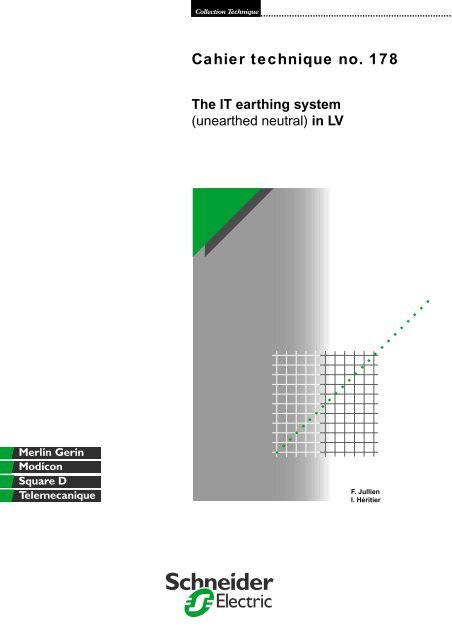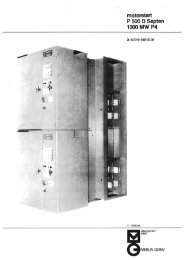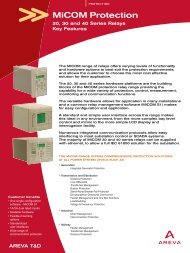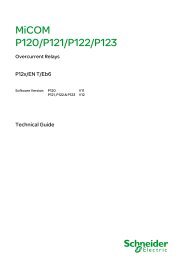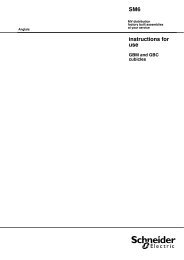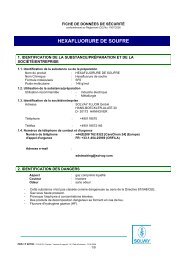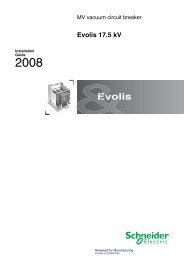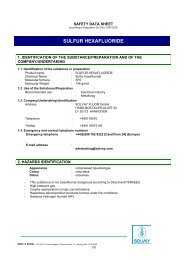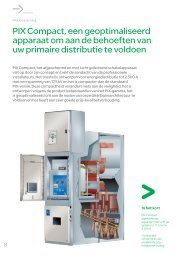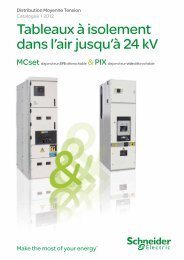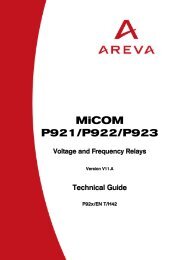The IT earthing system (unearthed neutral) in LV
The IT earthing system (unearthed neutral) in LV
The IT earthing system (unearthed neutral) in LV
You also want an ePaper? Increase the reach of your titles
YUMPU automatically turns print PDFs into web optimized ePapers that Google loves.
<strong>The</strong> <strong>IT</strong> <strong>earth<strong>in</strong>g</strong> <strong>system</strong>(<strong>unearthed</strong> neutral) <strong>in</strong> <strong>LV</strong>Although all Earth<strong>in</strong>g Systems offer users the same degree of safety, theydo not all have the same operat<strong>in</strong>g characteristics.This is why, <strong>in</strong> certa<strong>in</strong> countries, a specific <strong>earth<strong>in</strong>g</strong> <strong>system</strong> is stipulated bylegislation or standards accord<strong>in</strong>g to build<strong>in</strong>gs. For example, <strong>in</strong> France the<strong>IT</strong> <strong>system</strong> is compulsory <strong>in</strong> hospital operat<strong>in</strong>g theatres, and the TN-C isforbidden <strong>in</strong> premises where there is a risk of explosion.<strong>The</strong>se stipulations apart, dependability objectives (safety, availability,reliability, ma<strong>in</strong>tenability and proper operation of low currentcommunication <strong>system</strong>s) determ<strong>in</strong>e which <strong>earth<strong>in</strong>g</strong> <strong>system</strong> should bechosen for which <strong>in</strong>stallation.<strong>The</strong> aim of this “Cahier Technique” is to describe the advantages andareas of application of the <strong>IT</strong> <strong>earth<strong>in</strong>g</strong> <strong>system</strong>.After a brief <strong>in</strong>troduction of the electrical hazard and the various <strong>earth<strong>in</strong>g</strong><strong>system</strong>s, the first fault situations, followed by the double fault specific to the<strong>IT</strong> <strong>system</strong>, are studied, and the advantages and disadvantages of thisparticular <strong>earth<strong>in</strong>g</strong> <strong>system</strong> are developed. This “Cahier Technique” alsooffers solutions for the surge limiter with the various types of possibleovervoltages.F<strong>in</strong>ally, a choice table is provided for all <strong>earth<strong>in</strong>g</strong> <strong>system</strong>s, based on criteriafor safety, availability, electromagnetic compatibility and operators’professional requirements.Contents1 Introduction 1.1 Protection of persons aga<strong>in</strong>st electrical shocks p. 41.2 <strong>The</strong> various standardised <strong>earth<strong>in</strong>g</strong> <strong>system</strong>s p. 41.3 Choos<strong>in</strong>g an <strong>earth<strong>in</strong>g</strong> <strong>system</strong> p. 71.4 Type of <strong>in</strong>sulation p. 71.5 Equivalent <strong>system</strong> for an <strong>unearthed</strong> or impedance-earthedneutral network p. 82 <strong>The</strong> 1 st <strong>in</strong>sulation fault with the 2.1 Calculat<strong>in</strong>g fault currents and contact voltage p. 9<strong>IT</strong> <strong>earth<strong>in</strong>g</strong> <strong>system</strong>on the first fault2.2 Permanent <strong>in</strong>sulation monitors, history and pr<strong>in</strong>ciples p. 112.3 Track<strong>in</strong>g the 1 st <strong>in</strong>sulation fault p. 133 <strong>The</strong> 2 nd <strong>in</strong>sulation fault with the 3.1 Analysis of the double <strong>in</strong>sulation fault p. 15<strong>IT</strong> <strong>earth<strong>in</strong>g</strong> <strong>system</strong> 3.2 Elim<strong>in</strong>ation of the double <strong>in</strong>sulation fault p. 164 Special features of the <strong>IT</strong> <strong>earth<strong>in</strong>g</strong> <strong>system</strong> 4.1 Overvoltages <strong>in</strong> the <strong>IT</strong> <strong>system</strong> p. 184.2 Surge limiters p. 204.3 Why use an impedance? p. 215 Advantages and disadvantages 5.1 Increased availability p. 22of the <strong>IT</strong> <strong>earth<strong>in</strong>g</strong> <strong>system</strong> <strong>in</strong> <strong>LV</strong> 5.2 Increased safety aga<strong>in</strong>st risk of fire p. 225.3 Less downtime on control and monitor<strong>in</strong>g circuits p. 235.4 Usage limits and precautions of the <strong>IT</strong> <strong>earth<strong>in</strong>g</strong> <strong>system</strong> p. 236 Conclusion 6.1 Availability: an <strong>in</strong>creas<strong>in</strong>g need to be satisfied p. 266.2 <strong>The</strong> <strong>IT</strong> <strong>earth<strong>in</strong>g</strong> <strong>system</strong> f<strong>in</strong>ds its true place p. 266.3 <strong>The</strong> added advantage of safety p. 266.4 In short p. 27Bibliography p. 28Cahier Technique Schneider Electric no. 178 / p.3
1 Introduction1.1 Protection of persons aga<strong>in</strong>st electric shocksUse of Safety by Extra Low Voltage (< 25 V)-SE<strong>LV</strong>- is the most drastic solution s<strong>in</strong>ce itelim<strong>in</strong>ates the electrical hazard. However it isapplicable only <strong>in</strong> low power distribution.Regard<strong>in</strong>g everyday use of electricity, a number ofstudies have identified the causes of electric shocksand provided specific solutions for each one.Electric shocks have two causes, namely:c direct contact, i.e. a person or an animaltouch<strong>in</strong>g an exposed live conductor;c <strong>in</strong>direct contact, i.e. a person touch<strong>in</strong>g themetal frame of an electrical load on which an<strong>in</strong>sulation fault has occurred.Protection aga<strong>in</strong>st direct contactTo provide protection aga<strong>in</strong>st direct contact,<strong>in</strong>sulation and/or distanc<strong>in</strong>g measures are taken.<strong>The</strong>se measures can be re<strong>in</strong>forced <strong>in</strong> f<strong>in</strong>aldistribution by additional protection <strong>in</strong> the form ofa high sensitivity Residual Current Device(RCD).Protection aga<strong>in</strong>st <strong>in</strong>direct contactWith respect to protection aga<strong>in</strong>st <strong>in</strong>directcontact, between an accidentally energisedframe and the earth, the basic solution is to earthall the load frames via the protective conductors.However, this measure does not rule out theexistence of a contact voltage hazardous forpersons if it exceeds the conventional limit safetyvoltage U L def<strong>in</strong>ed by standard IEC 60479.This contact voltage depends on the <strong>earth<strong>in</strong>g</strong><strong>system</strong>s def<strong>in</strong>ed <strong>in</strong> the <strong>in</strong>ternational standardIEC 60364.1.2 <strong>The</strong> various standardised <strong>earth<strong>in</strong>g</strong> <strong>system</strong>s<strong>The</strong> three <strong>earth<strong>in</strong>g</strong> <strong>system</strong>s given official statusby <strong>in</strong>ternational standards (IEC 60364) are alsostipulated by a large number of nationalstandards: <strong>in</strong> France by the <strong>LV</strong> <strong>in</strong>stallationstandard: NF C 15-100.A brief rem<strong>in</strong>der of the protection pr<strong>in</strong>ciple ofthese <strong>system</strong>s will now be given beforedescrib<strong>in</strong>g the <strong>IT</strong> <strong>system</strong> <strong>in</strong> greater detail.<strong>The</strong> TN <strong>system</strong>c Its pr<strong>in</strong>ciple:v the transformer neutral is earthed;v the electrical load frames are connected toneutral.This type of <strong>system</strong> has three possibilities:v the same conductor acts as a neutral and aprotective conductor: this is the TN-C <strong>system</strong>;v the neutral and the protective conductor areseparate: this is the TN-S <strong>system</strong>;v and the comb<strong>in</strong>ation of these two <strong>system</strong>s,known as TN-C-S when the neutral and theprotective conductor are separated downstreamof part of the <strong>in</strong>stallation <strong>in</strong> the TN-C <strong>system</strong>.Note that the TN-S cannot be placed upstreamof the TN-C.c Its operation (see fig. 1 ):An <strong>in</strong>sulation fault on a phase becomes a shortcircuitand the faulty part is disconnected by aShort-Circuit Protection Device (SCPD).<strong>The</strong> TT <strong>system</strong>c Its pr<strong>in</strong>ciple:v the transformer neutral is earthed;v the electrical load frames are also earthed.c Its operation (see fig. 2 ):<strong>The</strong> current of an <strong>in</strong>sulation fault is limited byearth connection impedance.Cahier Technique Schneider Electric no. 178 / p.4
a) b)I dI dNNPENSCPDPESCPDR BU dR dR BU dR dc)I d12N3NPENPEPESCPDR BU dR dFig. 1 : <strong>in</strong>sulation fault on a network operated <strong>in</strong> TN-C [a], TN-S [b] and TN-C-S [c].NRCDI dProtection is provided by the Residual CurrentDevices (RCD): the faulty part is disconnectedas soon as the threshold I∆n, of the RCD placedupstream, is overshot by the fault current, so thatI∆n R B iU L .R B R AU dR dFig. 2 : <strong>in</strong>sulation fault on a network operated <strong>in</strong> TT.<strong>The</strong> <strong>IT</strong> <strong>system</strong>c Its pr<strong>in</strong>ciple:v the transformer neutral is not earthed, but istheoretically <strong>unearthed</strong>. In actual fact, it isnaturally earthed by the stray capacities of thenetwork cables and/or voluntarily by a highimpedance of around 1,500 Ω (impedanceearthedneutral);v the electrical load frames are earthed.Cahier Technique Schneider Electric no. 178 / p.5
c Its operation:v should an <strong>in</strong>sulation fault occur, a low currentdevelops as a result of the network’s straycapacities (see fig. 3a ).<strong>The</strong> contact voltage developed <strong>in</strong> the frameearth connection (no more than a few volts) isnot dangerous;v if a second fault occurs on another phasebefore the first fault has been elim<strong>in</strong>ated(see fig. 3b and 3c ), the frames of the loads <strong>in</strong>question are brought to the potential developedby the fault current <strong>in</strong> the protective conductor(PE) connect<strong>in</strong>g them. <strong>The</strong> SCPDs (for theframes <strong>in</strong>terconnected by the PE) or the RCDs(for the frames with separate earth connections)provide the necessary protection.This deliberately brief presentation of the various<strong>earth<strong>in</strong>g</strong> <strong>system</strong>s clearly cannot cover all thespecific <strong>in</strong>stallation possibilities. Readersrequir<strong>in</strong>g more details can consult “CahiersTechniques” no. 114, 172 and 173.a)N321Permanent<strong>in</strong>sulationmonitor(PIM)Z N : optionalimpedanceZ NSurgelimiterI dI dI I dNI CR BU dC1 C2 C3PEI C1 I C2 I C3I Cb)Permanent<strong>in</strong>sulationmonitor(PIM)NSurgelimiterI dI dSCPDI dI dSCPD321NPEUd2R d2U d1R d1R Bc)Permanent<strong>in</strong>sulationmonitor(PIM)NSurgelimiterI d RCDPESCPDI dI dSCPD321NPER BI dUd2R d2R AU d1R d1I dFig. 3 : s<strong>in</strong>gle [a] and double [b and c] <strong>in</strong>sulation fault on a network operated <strong>in</strong> <strong>IT</strong>.Cahier Technique Schneider Electric no. 178 / p.6
1.3 Choos<strong>in</strong>g an <strong>earth<strong>in</strong>g</strong> <strong>system</strong>Although all three <strong>earth<strong>in</strong>g</strong> <strong>system</strong>s offer users thesame degree of safety aga<strong>in</strong>st <strong>in</strong>direct contact,only the <strong>IT</strong> <strong>system</strong> guarantees risk-free cont<strong>in</strong>uityof supply <strong>in</strong> the presence of an <strong>in</strong>sulation fault.This undeniable advantage also has certa<strong>in</strong>drawbacks: for example the need to locate thisfirst fault and the possibility of overvoltagesoccurr<strong>in</strong>g that may affect operation of sensitiveloads.However, choice of <strong>earth<strong>in</strong>g</strong> <strong>system</strong> for an<strong>in</strong>stallation also depends on parameters otherthan safety of persons and cont<strong>in</strong>uity of supply,namely:c the environment (e.g. premises with a risk offire or sites frequently struck by lightn<strong>in</strong>g);c electromagnetic compatibility (EMC) (presence<strong>in</strong> the <strong>in</strong>stallation of harmonics and radiat<strong>in</strong>gfields, and sensitivity of equipment to suchphenomena);c technicity of <strong>in</strong>stallation designers andoperators;c ma<strong>in</strong>tenance quality and cost;c network size;c etc.Although consideration of the above parametersguarantees choice of the <strong>earth<strong>in</strong>g</strong> <strong>system</strong> mostsuited to the <strong>in</strong>stallation, it should be emphasisedthat the advantage offered by the <strong>IT</strong> <strong>system</strong> <strong>in</strong>terms of availability (2 nd fault most unlikely)generates <strong>in</strong>stallation and operat<strong>in</strong>g costs thatshould be compared with the downtime costsgenerated by other <strong>earth<strong>in</strong>g</strong> <strong>system</strong>s (operat<strong>in</strong>glosses and repair costs caused by the first<strong>in</strong>sulation fault).1.4 Type of <strong>in</strong>sulationCommon mode impedanceAll electrical networks have an impedance withrespect to earth known as the “common modeimpedance”, the orig<strong>in</strong> of which is <strong>in</strong>sulation ofnetwork cables and loads. This impedanceconsists of the leakage capacity and resistancebetween each live conductor and the earth.In <strong>LV</strong>, the leakage resistance of a new cable isaround 10 MΩ per kilometer and per phase,whereas its capacity evenly distributed withrespect to earth is approximately 0.25 µF, i.e.12.7 kΩ at 50 Hz.It should also be noted that <strong>in</strong> MV and HV thisleakage capacity is even greater and MUST betaken <strong>in</strong>to account when draw<strong>in</strong>g up a protectionplan (see “Cahier Technique” no. 62).Loads also have a natural leakage capacity,usually negligible.Effect of distributed capacity <strong>in</strong> the <strong>IT</strong> <strong>system</strong>In electrical <strong>in</strong>stallations, other capacities areadded to the network cable ones. This is thecase of certa<strong>in</strong> electronic loads that aregenerators of HF harmonic currents, <strong>in</strong> particularwhen they use the chopper pr<strong>in</strong>ciple (e.g. pulsewith modulation converters). However,ElectroMagnetic Compatibility (EMC) standardsstate that these HF currents must be shunted toearth, result<strong>in</strong>g <strong>in</strong> the presence of filters and thuscapacitors between phases and frame.Accord<strong>in</strong>g to the number of loads, theircontribution to the network’s “leakage” capacitycan be significant or even important.Measurements taken on a variety of electricalpower networks show that capacity variesconsiderably from network to network andcovers a range of a few µF to a few dozen µF.Excessively high capacities may question theadvantage of the <strong>IT</strong> <strong>earth<strong>in</strong>g</strong> <strong>system</strong>: if, on thefirst fault, the value of network impedance withrespect to earth means that contact voltageexceeds 50 V, safety of persons is notguaranteed. This is rare, however, as with a10 Ω earth connection, the network’s earthleakage capacity must exceed 70 µF (23 µF perphase if the neutral is not distributed).An <strong>IT</strong> network must therefore have a limitedcapacity with respect to earth, and the presenceof loads equipped with HF filters must be taken<strong>in</strong>to account <strong>in</strong> the network design stage.Cahier Technique Schneider Electric no. 178 / p.7
1.5 Equivalent <strong>system</strong> for a network with <strong>unearthed</strong> or impedance-earthed neutralA few def<strong>in</strong>itions and assumptions are givenbelow <strong>in</strong> order to def<strong>in</strong>e the equivalent <strong>system</strong>for this network (see fig. 4 ):c the neutral po<strong>in</strong>t is <strong>unearthed</strong> or earthed by animpedance (Z N ) of high value (normally 1 kΩ to2kΩ) whose earth connection is equivalent to aresistance (R B );c the load frames are <strong>in</strong>terconnected either fullyor by group. For EMC reasons (see“Cahier Technique” no. 187), it is advisable to<strong>in</strong>terconnect all the application frames of thesame <strong>in</strong>stallation and to connect them to thesame earth connection (resistance R A );c the earth connections (R A and R B ) are<strong>in</strong>terconnected (<strong>in</strong> most cases), or separate.NB: Two earth connections are considered to beseparate if they are more than 8 m apart;c each live conductor has, with respect to earth,an impedance made up of a resistance and acapacity.N321NPEZ NRN R1 R2 R3CN C1 C2 C3R BR AFig. 4 : equivalent <strong>system</strong> of a network with <strong>unearthed</strong> or impedance-earthed neutral.Cahier Technique Schneider Electric no. 178 / p.8
2 <strong>The</strong> 1 st <strong>in</strong>sulation fault with the <strong>IT</strong> <strong>earth<strong>in</strong>g</strong> <strong>system</strong>In normal operat<strong>in</strong>g conditions, safety of personsis guaranteed when contact voltage is less than50 V as per standard IEC 60364 (NF C 15-100).When this contact voltage is exceeded, thesestandards require automatic open<strong>in</strong>g of thecircuit. <strong>The</strong> follow<strong>in</strong>g section shows how use ofthe <strong>IT</strong> <strong>earth<strong>in</strong>g</strong> <strong>system</strong> for network operationprevents tripp<strong>in</strong>g on the first <strong>in</strong>sulation fault.2.1 Calculat<strong>in</strong>g fault currents and contact voltage on the first faultGeneral case (resistive fault)Should a fault with a resistive value Rd occurbetween phase 3 and the earth, a fault current I dflows <strong>in</strong> the neutral impedance and <strong>in</strong> thecapacities C1, C2 and C3 (see fig. 3a).Assum<strong>in</strong>g that the phase-to-earth capacities arebalanced (C1 = C2 = C3 = C), the fault currenthas the follow<strong>in</strong>g value:1+ 3j CωZI d =UN0Rd+ ZN + 3jCωZNRd<strong>The</strong> capacitive current is written as:3j CωZI c =UN0Rd+ ZN + 3jCωZNRdand the current <strong>in</strong> the impedance Z N :UI N =0Rd+ ZN + 3jCωZNRd<strong>The</strong> contact voltage U C (contact voltage betweenthe frame of a faulty device and another frame orthe earth) is calculated from the fault current I dflow<strong>in</strong>g <strong>in</strong> the earth connection resistance R A ofthe application frames if they are not<strong>in</strong>terconnected, else R B (only network earthconnection):U C = R A I d .Case of the full faultThis paragraph calculates the configurationgenerat<strong>in</strong>g the highest contact voltage (U C ):thus for a fault occur<strong>in</strong>g on a frame with earthconnection separate from that of Z N .By application of the above formulae, whereR d = 0, we obta<strong>in</strong>:UI d = 0ZN+ 3j CωUUc = R 0AZ N + 3j Cω<strong>The</strong> capacitive current is equal to:I C = +3j Cω U 0and the current <strong>in</strong> impedance Z N :UI N = 0ZNIn the various examples below, studied forZ N = ∞ (<strong>unearthed</strong> neutral) and Z N = 1 kΩ(impedance-earthed neutral), the calculationsare made for a network <strong>in</strong> the <strong>IT</strong> <strong>system</strong>,400 VAC (U 0 = 230 V), where:R A , earth connection resistance = 10 ΩR d , <strong>in</strong>sulation fault value = 0 to 10 kΩ.c Case 1:Low capacity network (e.g. limited to anoperat<strong>in</strong>g theatre)C1 = C2 = C3 = C = 0.3 µF per phase.c Case 2:Power network, whereC1 = C2 = C3 = C = 1.6 µF per phase.c Case 3:Very long power network, whereC1 = C2 = C3 = C = 10 µF per phase, i.e.roughly 40 km of cables!<strong>The</strong> results of all these calculations, grouped <strong>in</strong>the table <strong>in</strong> figure 5 , confirm the low faultvoltage (≈ 20 V <strong>in</strong> the most unfavourable cases),ensur<strong>in</strong>g cont<strong>in</strong>uity of operation, without risk forpersons, of a network designed us<strong>in</strong>g the <strong>IT</strong><strong>system</strong>. <strong>The</strong>y prove that addition of animpedance between the neutral and the earthhas very little effect on contact voltage.R d (kΩ) 0 0.5 1 10Case 1 Z N = ∞ U C (V) 0.72 0.71 0.69 0.22C R =1µF I d (A) 0.07 0.07 0.07 0.02Z N = 1 kΩ U C (V) 2.41 1.6 1.19 0.21I d (A) 0.24 0.16 0.12 0.02Case 2 Z N = ∞ U C (V) 3.61 2.84 1.94 0.23C R =5µF I d (A) 0.36 0.28 0.19 0.02Z N = 1 kΩ U C (V) 4.28 2.53 1.68 0.22I d (A) 0.43 0.25 0.17 0.02Case 3 Z N = ∞ U C (V) 21.7 4.5 2.29 0.23C R =30µF I d (A) 2.17 0.45 0.23 0.02Z N = 1 kΩ U C (V) 21.8 4.41 2.26 0.23I d (A) 2.18 0.44 0.23 0.02Fig. 5 : comparison of fault currents and contactvoltages on a first fault.Cahier Technique Schneider Electric no. 178 / p.9
<strong>The</strong> curves <strong>in</strong> figure 6 represent<strong>in</strong>g these resultsshow the considerable effect of network capacityon the value of U C .In po<strong>in</strong>t of fact, regardless of the distributedcapacity of the sound network or network onwhich a first fault has occurred, users can becerta<strong>in</strong> that this voltage will always be less thanthe conventional safety voltage and thus withoutrisk for persons. Also, the currents of a first fullfault are low and thus have m<strong>in</strong>imum destructiveor disturb<strong>in</strong>g (EMC) effect.Effect of distributed capacities, vector chartand neutral potentialc Effect of distributed capacities on a soundnetwork<strong>The</strong> capacities of all 3 phases create an artificialneutral po<strong>in</strong>t. In the absence of an <strong>in</strong>sulation fault,if network capacities are balanced, this neutralpo<strong>in</strong>t is then at earth potential (see fig. 7 ).In the absence of a fault, the phase-to-earthpotential is thus equal to phase to neutralvoltage for each phase.U c (V) whereZ n = 1,000 Ω10050C R = 70 µFC R = 30 µF10C R = 5 µF1C R = 1 µF0.1 R d (Ω)1 10 100 500 1,000 10 4(recommended threshold)Fig. 6 : contact voltage on a first <strong>in</strong>sulation fault is always less than safety voltage.11Artificial neutral32C C C 3C3 2Fig. 7 : the network’s distributed capacities create a connection between neutral and earth.Cahier Technique Schneider Electric no. 178 / p.10
c Vector chart <strong>in</strong> presence of a full faultIn event of a full fault on phase 1, the potential ofphase 1 is at earth potential (see fig. 8 ).<strong>The</strong> neutral-to-earth potential is thus equal tophase to neutral voltage V1, and that of phases2 and 3 with respect to earth is equal tophase-to-phase voltage. If the neutral isdistributed, the fault current is arithmetically<strong>in</strong>creased:I C = 4j Cω V1.However, detection, location and correction ofthis fault must be immediate <strong>in</strong> order to reducethe risk of a second simultaneous fault occurr<strong>in</strong>gwhich would result <strong>in</strong> open<strong>in</strong>g of the faulty circuits.a) b)23V 1NvN2v 3V 3 V 2II C3 d1T I V 1-T I = I V 3-T I = I V 2-T I TI C2V 1-T = 0V 3-T = V 1 + V 3V 2-T = V 1 + V 2I d = I C = I C2 + I C3I C2 = j C ω v 2I C3 = j C ω v 3I C = 3j C ω V 1I I d I = 3 C ω I V 1 IFig. 8 : vector charts of a network <strong>in</strong> the <strong>IT</strong> <strong>system</strong>, without fault [a] and with an earth fault on phase 1 [b].2.2 Permanent <strong>in</strong>sulation monitors, history and pr<strong>in</strong>ciples<strong>The</strong> first <strong>LV</strong> electrical distribution networks wereoperated us<strong>in</strong>g the <strong>IT</strong> <strong>earth<strong>in</strong>g</strong> <strong>system</strong>.Operators rapidly sought to detect the presenceof the first <strong>in</strong>sulation fault <strong>in</strong> order to prevent thehazards l<strong>in</strong>ked to a short-circuit current ofvary<strong>in</strong>g impedance and the de-energisation of afaulty feeder (with the lowest rat<strong>in</strong>g protection) orof the two faulty feeders.<strong>The</strong> first PIMs<strong>The</strong>se devices used 3 lamps connected betweenthe phases and the earth (see fig. 9 ).On a sound network, the three lamps form abalanced three-phase load, all lit and with thesame brilliance. When an <strong>in</strong>sulation fault occurs,one of the three lamps is short-circuited by thefault impedance. Voltage is reduced at theterm<strong>in</strong>als of this lamp, and lamp brilliancedecreases. However, voltage at the term<strong>in</strong>als ofthe other two lamps <strong>in</strong>creases until phase-tophasevoltage is reached. <strong>The</strong>ir lum<strong>in</strong>osity also<strong>in</strong>creases.This <strong>system</strong> is easy to <strong>in</strong>stall and use. However,given that its practical operat<strong>in</strong>g threshold is low,attempts were quickly made to try to detectimpedant faults <strong>in</strong> order to anticipate the full fault.For a DC network(supplied by batteries or by DC generator).<strong>The</strong> technique of the voltmeter balance(see fig. 10 ) was the first to be used, and<strong>in</strong>deed is still used today.(1)(2)(3)<strong>The</strong> OFF <strong>in</strong>dicatorlight <strong>in</strong>dicates thefaulty phase:<strong>in</strong> this case no. 3.(+) (-)R<strong>The</strong> needle <strong>in</strong>dicatesthe faulty polarity; <strong>in</strong> thiscase the (-) polarity.RFig. 9 : pr<strong>in</strong>ciple of the first PIM.Fig. 10 : pr<strong>in</strong>ciple of the PIM with voltmeter balance.Cahier Technique Schneider Electric no. 178 / p.11
<strong>The</strong> pr<strong>in</strong>ciple consists of measur<strong>in</strong>g andcompar<strong>in</strong>g voltages between the (+) polarity andthe earth, on the one hand, and the (-) polarityand the earth on the other. This pr<strong>in</strong>ciple makesauxiliary power sources unnecessary, s<strong>in</strong>ce thenetwork supplies the PIM directly viameasurement sensors (resistances).This technique applies to two-phase AC and DCnetworks and does not allow live fault track<strong>in</strong>g.For AC networks<strong>The</strong> most commonly used PIM are those with<strong>in</strong>sulation measurement by DC current <strong>in</strong>jection.Permanent measurement of <strong>in</strong>sulationresistance required use of active <strong>system</strong>s <strong>in</strong>place of the previously used passive <strong>system</strong>s.This resistance can be measured accurately <strong>in</strong>DC (see fig. 11 ), which is why the first PIMs,placed between the network and the earth,<strong>in</strong>jected a low DC current which flowed throughthe fault. This simple, reliable technique is stillextensively used today, but does not allow livefault track<strong>in</strong>g.Note that when these PIMs are used on mixednetworks (conta<strong>in</strong><strong>in</strong>g rectifiers without galvanic<strong>in</strong>sulation), they may be disturbed or evenVNI PIM321NPEI PIMR BFig. 11 : pr<strong>in</strong>ciple of PIM with current <strong>in</strong>jection.“bl<strong>in</strong>ded” if a fault is present on the DC part ofthe network.<strong>The</strong>se were followed by PIMs with AC current<strong>in</strong>jection at low frequency (< 10 Hz), operat<strong>in</strong>gon the same pr<strong>in</strong>ciple. Although these PIMsallow live fault track<strong>in</strong>g, they can be “misled” bycable capacities that are seen as <strong>in</strong>sulationfaults and disturbed by frequency converters(variable speed controllers).For all AC and DC networksF<strong>in</strong>ally, nowadays, given that networks arefrequently of the mixed AC/DC k<strong>in</strong>d as well asvariable frequency, the new PIMs are able tomonitor <strong>in</strong>sulation on all types of networks.c Some use squared wave pulses at very lowfrequency (≈ 1Hz). <strong>The</strong>y allow PIM not to bedisturbed by earth leakage capacities, as theyare then immediately loaded then unloaded bythe next strobe pulse of opposite sign. <strong>The</strong>y areuniversal <strong>in</strong> use and easily adapted to modernnetworks, <strong>in</strong> particular to those supply<strong>in</strong>g powerelectronic devices which often deform the ACpulse. However, their response time, depend<strong>in</strong>gon the network’s earth leakage capacity, may beas much as a few m<strong>in</strong>utes and does not allowthe detection of <strong>in</strong>termittent faults.c In order to compensate the usage restrictionsof these PIMs for very long networks andnetworks with a large number of capacitivefilters, the low frequency AC current <strong>in</strong>jectiontechnique has been improved by means of“synchronous demodulation” (see fig. 12 ): thistype of PIM applies a low frequency AC voltagebetween the network and the earth, measuresthe current flow<strong>in</strong>g back via network <strong>in</strong>sulationimpedance and calculates the voltage-currentshift.It is then possible to determ<strong>in</strong>e the resistive andcapacitive components of this current and thusrelate the threshold to the resistive componentonly. This upgrade, the result of digitaltechnology, comb<strong>in</strong>es the advantages of DCcurrent and low frequency AC current <strong>in</strong>jectionwithout their disadvantages.I BFBF~mAVI R-BF= U BFU BFR NetworkI C-BFC NetworkI C-BFI BFZ NetworkI R-BFFig. 12 : the low frequency AC current <strong>in</strong>jection technique has been improved by means of “synchronousdemodulation”, which enables the <strong>in</strong>sulation drop (resistive leakage) to be dist<strong>in</strong>guished from capacitive leakage.Cahier Technique Schneider Electric no. 178 / p.12
PIM standardsc <strong>The</strong> manufactur<strong>in</strong>g standardsStandard IEC 61557-8 is <strong>in</strong> existence s<strong>in</strong>ceFebruary 1997. It def<strong>in</strong>es the specialspecifications govern<strong>in</strong>g <strong>in</strong>sulation monitorsdesigned for permanent monitor<strong>in</strong>g, irrespectiveof the measurement pr<strong>in</strong>ciple, of <strong>in</strong>sulationresistance with respect to earth of <strong>unearthed</strong> ACand DC <strong>IT</strong> <strong>system</strong> networks, and of AC <strong>IT</strong><strong>system</strong> networks conta<strong>in</strong><strong>in</strong>g rectifiers suppliedwithout galvanic separation (transformer withseparate w<strong>in</strong>d<strong>in</strong>gs).It places particular emphasis on three po<strong>in</strong>ts.v Properly <strong>in</strong>form specifiers and contractors. <strong>The</strong>manufacturer must provide the characteristics ofthe devices he produces and <strong>in</strong> particular thosethat are dependent on network capacity(response time and threshold values).v Ensure that these devices are properly<strong>in</strong>tegrated <strong>in</strong> their electrical environment. Thisrequires compliance with the specifications ofstandards IEC 61326-1 and 61326-10concern<strong>in</strong>g ElectroMagnetic Compatibility(EMC).v Guarantee operat<strong>in</strong>g safety for users.<strong>The</strong> ma<strong>in</strong> stipulations are: device operat<strong>in</strong>gtest<strong>in</strong>g must be possible without <strong>in</strong>sert<strong>in</strong>g anadditional impedance between the monitorednetwork and the earth, sett<strong>in</strong>gs must beprotected to prevent modification by error or byunauthorised users, and impossibility of devicedisconnection (the need to use a tool fordisassembly).c <strong>The</strong> operat<strong>in</strong>g standardsAs concerns PIM sett<strong>in</strong>g, standard IEC 60364provides an <strong>in</strong>itial answer: “A PIM designedaccord<strong>in</strong>g to… is set at a value less than them<strong>in</strong>imum value of the <strong>in</strong>sulation resistancedef<strong>in</strong>ed for the <strong>in</strong>stallation <strong>in</strong> question”, i.e.greater than or equal to 0.5 MΩ for a circuit witha nom<strong>in</strong>al voltage greater than or equal to 500 V.Guide NF C 15-100 states: “…set at a valueroughly less than 20% of the resistance of the<strong>in</strong>stallation as a whole…”However, a clear dist<strong>in</strong>ction must be madebetween the <strong>in</strong>sulation resistance of the<strong>in</strong>stallation, which only takes electricaldistribution <strong>in</strong>to account, and the <strong>in</strong>sulation levelwhich is set for overall network monitor<strong>in</strong>g,<strong>in</strong>clud<strong>in</strong>g the various mach<strong>in</strong>es and switchgearconnected to it.In the previous chapter we saw that for faultsgreater than 500 Ω, contact voltage does notexceed 5 V with an earth connection of 10 Ω(see fig. 5). In practice, for a normal <strong>in</strong>dustrial<strong>in</strong>stallation, it is thus reasonable, without tak<strong>in</strong>grisks, to set the lower alarm threshold at a valueof between 500 Ω and 1,000 Ω, ensur<strong>in</strong>geffective fault track<strong>in</strong>g (and thus location of thereported <strong>in</strong>sulation fault). To organise preventivetrack<strong>in</strong>g, it is useful to have a first level thresholdaround 10 kΩ for example. This threshold mustbe adapted accord<strong>in</strong>g to <strong>in</strong>stallationcharacteristics and operat<strong>in</strong>g requirements. Notethat short networks allow a higher preventionthreshold.2.3 Track<strong>in</strong>g the 1 st <strong>in</strong>sulation faultWhen track<strong>in</strong>g a fault, although certa<strong>in</strong> operatorsmerely identify the faulty feeder, accuratedeterm<strong>in</strong>ation of the location of this fault isrecommended (e.g. damaged cable or <strong>in</strong>sulationfault <strong>in</strong> a device) <strong>in</strong> order to put it right as quicklyas possible.Track<strong>in</strong>g by successive de-energisation offeedersThis means of fault track<strong>in</strong>g is quoted formemory only. It consists of open<strong>in</strong>g the feedersone by one, beg<strong>in</strong>n<strong>in</strong>g with the ma<strong>in</strong> feeders.When the faulty feeder is opened, the current<strong>in</strong>jected by the PIM decreases markedly anddrops below the detection threshold. <strong>The</strong> audiblealarm normally controlled by the PIM then stops,enabl<strong>in</strong>g remote identification of the faultyfeeder.This procedure, which requires <strong>in</strong>terruption ofoperation on each feeder, is contrary to theoperat<strong>in</strong>g philosophy of the <strong>IT</strong> <strong>earth<strong>in</strong>g</strong> <strong>system</strong>,which stipulates cont<strong>in</strong>uity of supply. Althoughfrequently used <strong>in</strong> the past, it is graduallydisappear<strong>in</strong>g with the development of the newfault track<strong>in</strong>g <strong>system</strong>s which allow live track<strong>in</strong>g(without power break<strong>in</strong>g).Live track<strong>in</strong>gc Detect<strong>in</strong>g the fault currentAs seen above (see fig. 3a), a current I d flowsthrough the first <strong>in</strong>sulation fault at the samefrequency as that of the network (50 Hz or60 Hz), return<strong>in</strong>g to the source via the capacitiesof the other sound phases and via the neutralimpedance if any.An <strong>in</strong>itial live track<strong>in</strong>g method (without<strong>in</strong>terrupt<strong>in</strong>g distribution) consisted of us<strong>in</strong>g aclamp-on probe to measure the earth “leakage”current on each feeder. <strong>The</strong> faulty feeder wasthe one on which the highest value wasmeasured.This method has two drawbacks, namely:v It is not reliable for networks with a largenumber of feeders some of which are highlycapacitive (how can the earth current of a shortfaulty feeder be dist<strong>in</strong>guished from that of a longcapacitive feeder?).Cahier Technique Schneider Electric no. 178 / p.13
v It is not applicable on networks with fewcapacitive leakages (the fault current is virtuallyundetectable).In order to improve detection of the fault currentpath (at power frequency) us<strong>in</strong>g a clamp-onprobe, two “tricks” were used.<strong>The</strong> first consisted of <strong>in</strong>creas<strong>in</strong>g this fault currentby temporarily plac<strong>in</strong>g a low impedance <strong>in</strong>parallel on the PIM.<strong>The</strong> second consisted of dist<strong>in</strong>guish<strong>in</strong>g thecapacitive leakage currents from the fault currentby the periodic use of the above-quotedimpedance by means of a beat<strong>in</strong>g relay(approx. 2 Hz).c Detect<strong>in</strong>g an <strong>in</strong>jected currentThis method uses a low frequency s<strong>in</strong>usoidalpulse (i 10 Hz) <strong>in</strong>jected by a generator or a PIM.Choice of low frequency for fault track<strong>in</strong>gensures no disturbance by network leakagecapacities, but this frequency cannot be lessthan 2.5 Hz, as detection with a magnetic sensorbecomes difficult. This method uses devicessensitive to the <strong>in</strong>jected pulse only, that caneither be fixed with detection toroids placed onall feeders, or portable with a clamp-on probetuned to signal frequency <strong>in</strong> order to locate theexact position of the fault (see fig. 13 ).When the devices (generator, sensors and load)are fixed, live fault track<strong>in</strong>g can be automatic ondetection of a fault, with transmission of an orderby the PIM.c Measur<strong>in</strong>g <strong>in</strong>sulation of each feederOperators, with their ever-<strong>in</strong>creas<strong>in</strong>g need forcont<strong>in</strong>uity of supply, are no longer prepared evento wait for the first fault, but want to be able toprogramme ma<strong>in</strong>tenance work and thusanticipate the next feeder likely to be affected byan <strong>in</strong>sulation fault.It is thus necessary to “monitor” the changes <strong>in</strong><strong>in</strong>sulation of each feeder and to carefully identifythe resistive and capacitive <strong>in</strong>sulation components.<strong>The</strong> synchronous demodulation pr<strong>in</strong>ciple canalso be used by measur<strong>in</strong>g, first, the <strong>in</strong>jectioncurrent flow<strong>in</strong>g <strong>in</strong> the feeders (by the toroidsensors) and, second, the <strong>in</strong>jection voltage.Development of this track<strong>in</strong>g method isencouraged by application of digital techniquesto the management of electrical power distribution(see “Cahier Technique” no. 186): the user cannow remotely and cont<strong>in</strong>ually monitor <strong>in</strong>sulationchanges of the various feeders. Use of digitalbuses enables data to be centralised on asupervisor, displayed and logged, thus allow<strong>in</strong>g<strong>in</strong>telligent, predictive ma<strong>in</strong>tenance.Fixed load with manualor automatic scann<strong>in</strong>gLF generator(G)GPIM ( )N12 3 N/ / / /PER BManual loadFig. 13 : track<strong>in</strong>g can take place with fixed or portable devices sensitive to the <strong>in</strong>jected pulse.PECahier Technique Schneider Electric no. 178 / p.14
3 <strong>The</strong> 2 nd <strong>in</strong>sulation fault with the <strong>IT</strong> <strong>earth<strong>in</strong>g</strong> <strong>system</strong>As we have already seen <strong>in</strong> the previouschapter, the advantage of us<strong>in</strong>g the <strong>IT</strong> <strong>system</strong> <strong>in</strong>network operation lies <strong>in</strong> the possibility ofcont<strong>in</strong>uity of supply even though an <strong>in</strong>sulationfault has occurred on a circuit.This message has been received loud and clearby standard drafters who, <strong>in</strong> order to ma<strong>in</strong>ta<strong>in</strong> ahigh level of availability, stipulate <strong>in</strong> <strong>in</strong>stallationstandards <strong>in</strong>dication and track<strong>in</strong>g of this first faultso as not to fear a second fault. Protectiondevices are also provided for this second fault <strong>in</strong>order to guarantee the same level of safety ofpersons as for the TN and TT <strong>earth<strong>in</strong>g</strong> <strong>system</strong>s.<strong>The</strong> two sections below study the fault currentsand contact voltage which depend on how theframes are earthed. <strong>The</strong>re are two possibilities,namely:c <strong>The</strong> load frames are all <strong>in</strong>terconnected by aPE protective conductor: this is the generalcase.c <strong>The</strong> frames are not <strong>in</strong>terconnected and areconnected to separate earth connections(configuration to be avoided due to EMC:see “Cahier Technique” no. 187).3.1 Analysis of the double <strong>in</strong>sulation faultIn this section, fault currents and contact voltageare calculated by consider<strong>in</strong>g two full <strong>in</strong>sulationfaults on two different live conductors (on onephase and the neutral if the neutral is distributed,or on two different phase conductors if theneutral is not distributed) of two circuits ofidentical cross-section and length.This assumption, which results <strong>in</strong> a m<strong>in</strong>imumfault current, is the one normally chosen tocalculate the maximum lengths protected by theshort-circuit protection devices.Contact voltage and double fault currentwhen the frames are <strong>in</strong>terconnectedWhen a fault current occurs between two faultyframes, a current flows <strong>in</strong> the phase conductorsand the PE protective conductor ensur<strong>in</strong>g<strong>in</strong>terconnection of frames (see fig. 3b).This current is only limited by the impedance ofthe fault loop equal to the sum of theimpedances of the live conductors concernedand the circuit of the equipotential l<strong>in</strong>ks (PE).<strong>The</strong>re are a number of methods for calculat<strong>in</strong>gfault currents for an electrical <strong>in</strong>stallation (see“Cahier Technique” no. 158).In this case, the conventional method has beenchosen, as it enables calculation of fault currentand contact voltage values without mak<strong>in</strong>g toomany assumptions on <strong>in</strong>stallation characteristics.It will thus be used from now on <strong>in</strong> this “CahierTechnique” to give an idea of the value of thecurrents and voltages <strong>in</strong>volved on a double fault<strong>in</strong> the <strong>IT</strong> <strong>system</strong>.It is based on the simplified assumption thatconsiders that, dur<strong>in</strong>g the duration of the fault,the voltage at the orig<strong>in</strong> of the feeder consideredis equal to 80% of <strong>in</strong>stallation nom<strong>in</strong>al voltage.This assumes that the impedance of the feeder<strong>in</strong> question accounts for 80% of total impedanceof the faulty loop, and that upstream impedanceaccounts for 20%.For the follow<strong>in</strong>g calculations:U’ = phase to neutral voltage, (= U 0 if one of thetwo faults is on the distributed neutral),orU’ = phase-to-phase voltage, (= e U 0 if theneutral is not distributed).R a = ρ L = resistance of the live conductorS a(phase or neutral) of the circuit on which the faultoccurred.R pe = ρ L = resistance of the circuit protectiveS peconductor.S a = cross-section of the live conductor.S pe = cross-section of the protective conductor.L = length of the faulty circuits.m = Sa= ratio of live conductor cross-sectionSpeover protective conductor cross-section(normally i 1).c If we consider that the live and PE conductorsof the two faulty feeders have the same crosssectionand length and if we ignore their reactance:v if one of the faults is on the neutral0,8 UI0Sd =, i.e. Ia2R ( a + R pe )d =0,8U 02ρ ( 1+mL ),v if the double fault concerns two phaseSconductors Iad =0,8eU0 .2 ρ 1 + mL( )Cahier Technique Schneider Electric no. 178 / p.15
c <strong>The</strong> correspond<strong>in</strong>g contact voltage isU C =R pe I d , i.e.:v if one of the faults is on the neutralmU =0,8U ,c 0 or21 ( + m)v if the double fault concerns two phasemconductors U c=0,8eU021 ( + m ).NB: this method is not applicable for <strong>in</strong>stallationssupplied by generator set, as, due to highgenerator impedance compared with theimpedance of the supplied network, voltage atthe orig<strong>in</strong> of the network <strong>in</strong> question is low whena fault occurs (> 400 0.02 0.08Fig. 16 : maximum break<strong>in</strong>g time specified for the <strong>IT</strong><strong>earth<strong>in</strong>g</strong> <strong>system</strong> by <strong>in</strong>stallation standards (* for s<strong>in</strong>glephasenetworks).c Protection of the neutral conductor when it isdistributed.Figure 3b shows that when a double fault occurs,the two SCPDs detect the fault current but eachone on a s<strong>in</strong>gle phase or on the neutral.This situation calls for particular monitor<strong>in</strong>g ofSCPD characteristics: this is because if thecables of the two feeders have similar crosssections,the two SCPDs play an equal role <strong>in</strong>break<strong>in</strong>g, but if the cross-sections are different,there is a risk of only one SCPD, the one withCahier Technique Schneider Electric no. 178 / p.16
the lowest rat<strong>in</strong>g, perform<strong>in</strong>g break<strong>in</strong>g. It is thusnecessary to verify that its break<strong>in</strong>g capacity onone phase, thus under e U 0 , is greater than I d .For this reason, circuit-breaker manufacturersspecify the s<strong>in</strong>gle-phase break<strong>in</strong>g capacities oftheir devices accord<strong>in</strong>g to each nom<strong>in</strong>al voltage,and standard IEC 60947-2 specifies a testsequence for circuit-breakers designed forprotection of <strong>IT</strong> networks. Devices fail<strong>in</strong>g tosatisfy the requirements of these tests must bemarked: <strong>IT</strong>Protection must also be confirmed for the neutralconductor when its cross-section is less thanthat of the phase conductors. Note that four-polecircuit-breakers (the fourth pole has a half rat<strong>in</strong>g)can be used to protect cables with neutral crosssectionhalf of phase cross-section.It should be stressed that four-pole SCPDs arebecom<strong>in</strong>g <strong>in</strong>creas<strong>in</strong>gly necessary, irrespective ofthe <strong>in</strong>stallation <strong>earth<strong>in</strong>g</strong> <strong>system</strong> used (TN, TT or<strong>IT</strong>), due to the proliferation of harmonics <strong>in</strong>networks, and thus that the neutral can beoverloaded by harmonic currents of rank 3 andmultiples.c Fuse protection<strong>The</strong> fuse blow<strong>in</strong>g zone is located between twoenvelope curves.Us<strong>in</strong>g the expression of current I d , def<strong>in</strong>ed <strong>in</strong> theprevious chapter, and the condition I fu < I d , it ispossible to determ<strong>in</strong>e the maximum length of theprotected circuit.v If the neutral conductor is distributed:L = 0,8 U 0 S 1max.2ρ ( 1+ m) Ifuv If the neutral conductor is not distributed:L = 0,8 e U 0 S phmax.1+ m2ρ ( ) I fuI fu corresponds to the fuse blow<strong>in</strong>g current with<strong>in</strong>a maximum time stipulated by the standards.It should be checked that this time is compatiblewith protection of persons <strong>in</strong> event of a doublefault.Note that use of fuses <strong>in</strong> the <strong>IT</strong> <strong>earth<strong>in</strong>g</strong> <strong>system</strong>often clashes with the need for multi-polebreak<strong>in</strong>g, <strong>in</strong>clud<strong>in</strong>g that of the neutral conductorwhen distributed.c Circuit-breaker protectionProtection of persons is guaranteed when thefault current is greater than the circuit-breaker’sshort time delay protection sett<strong>in</strong>g.Just as with fuses, the maximum length of theprotected circuit can be determ<strong>in</strong>ed accord<strong>in</strong>g tothe expression of current I d , def<strong>in</strong>ed <strong>in</strong> theprevious chapter and the condition I m < I d .<strong>The</strong> maximum length of the circuit protected by acircuit-breaker is:v with the distributed neutral conductor:SL =0,8U amax 02ρ ( 1+m) I.mv with the non-distributed neutral conductor:SL max =0,8eUa02 ρ ( 1+m ) I.mNote that whether protection is provided by fuse orcircuit-breaker, the fact of distribut<strong>in</strong>g the neutral<strong>in</strong> <strong>IT</strong> divides by e the maximum length protected.c Improvement of tripp<strong>in</strong>g conditions.When tripp<strong>in</strong>g conditions are not satisfied(lengths greater than maximum lengthsprotected), the follow<strong>in</strong>g measures can be taken:v reduce the value of I m of the circuit-breakers:however current discrim<strong>in</strong>ation between circuitbreakersmay be reduced as a result;v <strong>in</strong>crease PE conductor cross-section. <strong>The</strong>impedance of the return circuit of the double faultcurrent is thus reduced and enables an <strong>in</strong>crease<strong>in</strong> maximum length for protection of persons.However, although contact voltage will bereduced, the electrodynamic stresses on thecables will <strong>in</strong>crease.v Increase live conductor cross-section. This isthe most expensive solution and also results <strong>in</strong>an <strong>in</strong>crease <strong>in</strong> three-phase short-circuit currents.v F<strong>in</strong>ally, there is a simple solution that requiresno calculation: use of low sensitivity RCDs onvery long feeders. This solution is also possible<strong>in</strong> <strong>IT</strong>, as the PE conductor is separate from theneutral conductor which is not the case <strong>in</strong> TN-C.Case of application frames with separateearth connectionsWhen an <strong>in</strong>stallation supplies a number ofseparate build<strong>in</strong>gs at a distance from oneanother, their application frames are oftenconnected to separate earth connections. <strong>The</strong>impedance of the path of fault current I d is then<strong>in</strong>creased by the resistance of the two earthconnections <strong>in</strong> question, and the conditionnecessary for protection of persons (respect ofmaximum break<strong>in</strong>g times) can no longer beguaranteed by the short-circuit protection devices.<strong>The</strong> simplest study and <strong>in</strong>stallation solution is touse RCDs. <strong>The</strong>ir sett<strong>in</strong>gs follow the same rulesas <strong>in</strong> TT.To derive maximum benefit from the cont<strong>in</strong>uity ofsupply offered by the <strong>IT</strong> <strong>system</strong>, the RCDs mustbe prevented from tripp<strong>in</strong>g on the first fault bynot sett<strong>in</strong>g their threshold IDn at too low a level,particularly for circuits with a high leakagecapacity, while at the same time respect<strong>in</strong>g the<strong>in</strong>equation: I∆n
4 Special features of the <strong>IT</strong> <strong>earth<strong>in</strong>g</strong> <strong>system</strong>4.1 Overvoltages <strong>in</strong> the <strong>IT</strong> <strong>system</strong>Electrical networks can be subject toovervoltages of vary<strong>in</strong>g orig<strong>in</strong>s.Some overvoltages, such as differential modeones (between live conductors) affect all the<strong>earth<strong>in</strong>g</strong> <strong>system</strong>s. Readers requir<strong>in</strong>g more<strong>in</strong>formation on this subject should consult“Cahier Technique” no. 179.This section is particularly concerned withcommon mode overvoltages, which ma<strong>in</strong>ly affectthe <strong>IT</strong> <strong>system</strong> as the network is then“<strong>unearthed</strong>”:c overvoltages due to <strong>in</strong>sulation faults,c overvoltages due to <strong>in</strong>ternal disruptivebreakdown <strong>in</strong> the MV/<strong>LV</strong> transformer,c overvoltages due to lightn<strong>in</strong>g strik<strong>in</strong>g theupstream <strong>LV</strong> network,c overvoltages due to lightn<strong>in</strong>g strik<strong>in</strong>g thebuild<strong>in</strong>g <strong>in</strong> which the <strong>in</strong>stallation is housed.<strong>The</strong>se overvoltages are particularly taken <strong>in</strong>toaccount by standard NF C 15-100 whichstipulates <strong>in</strong>stallation of a surge limiterdownstream of an MV/<strong>LV</strong> transformer and whenthere is a risk of lightn<strong>in</strong>g (overhead l<strong>in</strong>es).Overvoltages due to <strong>in</strong>sulation faultsc When the first <strong>in</strong>sulation fault occurs, thephase-to-earth voltage of the sound phases ispermanently brought to the phase-to-phasevoltage of the network.<strong>LV</strong> equipment must thus be designed towithstand a phase-to-earth voltage of U 0 e andnot the phase to neutral voltage U 0 for the timerequired to track and elim<strong>in</strong>ate the fault. Thisparticularly applies to:v “Y” capacitive filters fitted on many electronicdevices;v <strong>in</strong>stallation PIM when <strong>in</strong>stalled between phaseand earth because the neutral is not accessible.When choos<strong>in</strong>g a PIM, it is thus important toverify the voltage of the network to be monitoreddeclared by its manufacturer.<strong>The</strong>se recommendations are specified <strong>in</strong>particular <strong>in</strong> standard IEC 60950.c On occurrence of the first fault, a transientovervoltage appears with a possible peak of2.7 x r U 0 (U 0 = phase to neutral voltage of the<strong>LV</strong> network). On a 230 V/400 V network, thisvalue is 880 V, an overvoltage level that is notdangerous for equipment with an <strong>in</strong>sulation of1,800 V (voltage constra<strong>in</strong>t at power frequencyon the <strong>LV</strong> side as per IEC 60364-4-442).Note that these overvoltages do not causepermanent short-circuit<strong>in</strong>g of the surge limiter.Overvoltages due to <strong>in</strong>termittent <strong>in</strong>sulationfaultsIntermittent faults (accord<strong>in</strong>g to <strong>in</strong>ternationalelectrotechnical vocabulary, or “restrict<strong>in</strong>g” or“arc<strong>in</strong>g” faults <strong>in</strong> Anglo-saxon literature) behavelike a series of transient faults.Experience and theoretical studies show that<strong>in</strong>termittent faults can generate overvoltages andthus result <strong>in</strong> equipment destruction. Suchovervoltages are particularly observed on MVnetworks operated with an earthed connectionby a tuned limit<strong>in</strong>g reactance (Petersen coil).<strong>The</strong>se overvoltages are caused by <strong>in</strong>completedischarg<strong>in</strong>g of zero sequence capacity onre-arc<strong>in</strong>g. <strong>The</strong> zero sequence voltage therefore<strong>in</strong>creases each time the arc is ignited. Assum<strong>in</strong>gthat the arc is ignited at the highest value of thephase-to-earth voltage of the faulty phase, andzero sequence voltage <strong>in</strong>creases each time,overvoltages of 5 to 6 times phase to neutralvoltage may be generated.Yet aga<strong>in</strong>, <strong>in</strong> the <strong>IT</strong> <strong>system</strong>, protection isprovided by the surge limiter, and presence of animpedance between neutral and earthencourages rapid discharg<strong>in</strong>g of the zerosequence capacity.Overvoltages due to <strong>in</strong>ternal disruptivebreakdown of the MV/<strong>LV</strong> transformerVoltage withstand at power frequency of <strong>LV</strong>equipment is def<strong>in</strong>ed <strong>in</strong> standardIEC 60364-4-442 which specifies their valuesand durations (see fig. 17 ).c Internal disruptive breakdown between theMV/<strong>LV</strong> w<strong>in</strong>d<strong>in</strong>gs. This k<strong>in</strong>d of overvoltage is atnetwork frequency.Acceptable AC voltageson <strong>LV</strong> equipmentU 0 + 250 V (i.e. 650 V <strong>in</strong> <strong>IT</strong>) > 5Break<strong>in</strong>gtime (s)U 0 + 1,200 V (i.e. 1600 V <strong>in</strong> <strong>IT</strong>) * i 5(*) For an <strong>IT</strong> network, the voltage U 0 must be replacedby the voltage e U 0 .Fig. 17 : acceptable AC voltage constra<strong>in</strong>ts on <strong>LV</strong><strong>in</strong>stallation equipment <strong>in</strong> the <strong>IT</strong> <strong>system</strong> for a 230/400 Vnetwork.Cahier Technique Schneider Electric no. 178 / p.18
<strong>The</strong>se overvoltages are rare and their “sudden”appearance means that the surge limiter, whosecerta<strong>in</strong> arc<strong>in</strong>g voltage is set at least at 2.5 timestype voltage (NF C 63-150), i.e. for example750 V for a limiter placed on the neutral of a230/400 V network, immediately earths the <strong>LV</strong>network, prevent<strong>in</strong>g it from ris<strong>in</strong>g to MV potential.c MV/frame <strong>in</strong>ternal disruptive breakdown alsoknown as “return disruptive breakdown”When the transformer frame and the <strong>LV</strong> networkare connected to the same earth connection(see fig. 18 ) there is a risk of <strong>LV</strong> equipmentdisruptive breakdown if the voltage R p Ih MTexceeds equipment dielectric withstand, with R p(earth connection resistance) and Ih MT (zerosequence current due to MV disruptivebreakdown).One solution is to connect the <strong>LV</strong> <strong>in</strong>stallationframes to an earth connection that is electricallyseparate from that of the substation frames.However, <strong>in</strong> practice, this separation is difficultdue to frame mesh<strong>in</strong>g <strong>in</strong> MV/<strong>LV</strong> substations.Consequently standard IEC 60364-4-442 statesthat the <strong>LV</strong> <strong>in</strong>stallation frames can be connectedto the earth connection of the transformersubstation frames if the voltage R p Ih MT iselim<strong>in</strong>ated with<strong>in</strong> the stipulated times.Overvoltages due to lightn<strong>in</strong>g strik<strong>in</strong>g theupstream MV networkWhen lightn<strong>in</strong>g strikes the MV network, a waveis transmitted to the live conductors on the <strong>LV</strong>side as a result of capacitive coupl<strong>in</strong>g betweenthe transformer w<strong>in</strong>d<strong>in</strong>gs.If the <strong>in</strong>stallation is <strong>in</strong> <strong>IT</strong>, the surge limiterabsorbs the overvoltage occurr<strong>in</strong>g on the liveconductor to which it is connected (neutral orphase) and is short-circuited if this overvoltage isvery high: the network can then be compared toa network <strong>in</strong> TN-S. Experience andmeasurements have resulted <strong>in</strong> the follow<strong>in</strong>gobservations:c Overvoltages of around 2 kV occur at the endof short cables (10 m) irrespective of load and<strong>earth<strong>in</strong>g</strong> <strong>system</strong>.c Higher overvoltages occur at the end of cableswith open end or which supply loads likely togenerate resonance. Even with a resistive load,overvoltages exist (see fig. 19 ), caused by wavepropagation and reflection phenomena and bycapacitive coupl<strong>in</strong>g between conductors.In view of the waveform of these overvoltages,the surge limiter is effective on the conductor towhich it is connected. Consequently, regardlessof the <strong>earth<strong>in</strong>g</strong> <strong>system</strong>, we strongly recommendthat surge arresters be <strong>in</strong>stalled at the orig<strong>in</strong> ofthe <strong>LV</strong> network, between all live conductors andHVMVNIh MTMV<strong>LV</strong>R T (R p )Fig. 18 : when the substation frames (MV) and the PEearth connection (<strong>LV</strong>) are connected to the same earthconnection, the <strong>LV</strong> load frames are brought to thepotential Ih MT R p.û (kV) Ph/Ph Ph/PE Ph/N N/PE PE/deepearthSystem :c <strong>IT</strong> 0.38 4.35 0.20 4.30 1.62c TN-S 0.36 4.82 0.20 4.72 1.62Fig. 19 : overvoltages, caused by a lightn<strong>in</strong>g shockwave, measured at the end of a 50m cable supply<strong>in</strong>g aresistive load.the earth, if there is a risk of the upstream MVnetwork be<strong>in</strong>g directly struck by lightn<strong>in</strong>g (caseof overhead l<strong>in</strong>es) and especially if the <strong>LV</strong>network is also at risk. <strong>The</strong> surge limitercont<strong>in</strong>ues to perform its function for MV/<strong>LV</strong>disruptive breakdown.Overvoltages due to lightn<strong>in</strong>g strik<strong>in</strong>g thebuild<strong>in</strong>g hous<strong>in</strong>g the <strong>in</strong>stallation<strong>The</strong>se overvoltages are caused by lightn<strong>in</strong>gcurrent flow<strong>in</strong>g through the build<strong>in</strong>g’s earthconnection, particularly when lightn<strong>in</strong>g strikes abuild<strong>in</strong>g equipped with a lightn<strong>in</strong>g rod.<strong>The</strong> entire earth network then markedly rises <strong>in</strong>potential with respect to the deep earth. <strong>The</strong> <strong>LV</strong>network, immediately earthed by the surgelimiter, changes from the <strong>IT</strong> to the TN-S <strong>system</strong> ifall the application frames are <strong>in</strong>terconnected.<strong>The</strong> lightn<strong>in</strong>g energy thus flown off can beconsiderable and require replacement of thelimiter.In order to m<strong>in</strong>imise these overvoltages onelectrical <strong>in</strong>stallations, the build<strong>in</strong>g’s horizontaland vertical equipotentiality must be the bestpossible <strong>in</strong> low and high frequency. A s<strong>in</strong>gleearth circuit (PE network) is naturallyrecommended, and use of metal cable trays withproper electrical connections (braids) is highlyadvisable for distribution.Cahier Technique Schneider Electric no. 178 / p.19
4.2 Surge limitersNom<strong>in</strong>al voltage Arc<strong>in</strong>g U (V) Example : limiter to beof a limiter -Un- at power on 1.2/50 chosen for a 230/400 V(V) (NF C 63-150) frequency impulse wave network…250 400 < U < 750 < 1,750 … if connected betweenthe earth and the neutral.440 700 < U < 1,100 < 2,500 … if connected betweenthe earth and the phase.660 1100 < U < 1,600 < 3,500Fig. 20 : the nom<strong>in</strong>al voltage of a surge limiter must be adapted to network voltage.<strong>The</strong> previous section clearly expla<strong>in</strong>s why thesurge limiter is an “essential accessory” of the<strong>IT</strong> <strong>earth<strong>in</strong>g</strong> <strong>system</strong> and thus stipulated bystandards. It also protects the PIM aga<strong>in</strong>stovervoltages.Its clipp<strong>in</strong>g thresholds for overvoltages at powerfrequencies and for common mode impulseovervoltages are def<strong>in</strong>ed by standardNF C 63-150 (see fig. 20 ). <strong>The</strong>se thresholds arelower than the specified withstand of equipmentused on <strong>LV</strong> networks (230/400 V).It must be connected as close as possible to theMV/<strong>LV</strong> transformer between neutral and earth,or between a phase and earth if thetransformer’s secondary connection is of thedelta or non-distributed neutral k<strong>in</strong>d.NB:c limiters are not necessary on networksdownstream of a <strong>LV</strong>/<strong>LV</strong> transformer,c standard IEC 60364 does not specify use ofsurge limiters, as it considers that occurrence ofan MV/<strong>LV</strong> fault is rare. However, when this faultdoes occur, its consequences are frequentlyserious.OperationA surge limiter consists of two conductivecomponents separated by an <strong>in</strong>sulat<strong>in</strong>g film(see fig. 21 ).Impulse overvoltages generate arc<strong>in</strong>g betweenthe two conductive components, but do notshort-circuit the limiter.Energetic overvoltages melt the <strong>in</strong>sulat<strong>in</strong>g film,thus allow<strong>in</strong>g the run-off of a high current toearth. <strong>The</strong> cartridge must then be replaced: itsshort-circuit<strong>in</strong>g is reported by the PIM just as an<strong>in</strong>sulation fault. Moreover, it is useful, for livefault track<strong>in</strong>g, to consider its earth connection <strong>in</strong>the same way as a feeder, particularly if thisconnection is normally <strong>in</strong>accessible (such aswhen, for example, the limiter is placed <strong>in</strong> thetransformer cubicle).Important characteristicWhen all the application frames are properly<strong>in</strong>terconnected, the double fault concern<strong>in</strong>g boththe arced surge limiter and an <strong>in</strong>sulation fault on“Insulat<strong>in</strong>g film”disappears dur<strong>in</strong>ghigh powerovervoltagesArc<strong>in</strong>g zone dur<strong>in</strong>glow power overvoltagesInsulat<strong>in</strong>g caseConnection padFig. 21 : surge limiter pr<strong>in</strong>ciple (Merl<strong>in</strong> Ger<strong>in</strong> Cardewtype).a phase, becomes a short-circuit. Limiterwithstand must then be sufficient for the timerequired to elim<strong>in</strong>ate the fault current (Forexample, 40 kA must be withstood for 0.2 sec forMerl<strong>in</strong> Ger<strong>in</strong> Cardew limiters).In the rare case of the second <strong>in</strong>sulation faultoccurr<strong>in</strong>g upstream of the <strong>in</strong>com<strong>in</strong>g circuitbreaker,the double fault is elim<strong>in</strong>ated by theMV protection devices (just as for an upstreamshort-circuit on the ma<strong>in</strong> <strong>LV</strong> switchboard).For this reason, the time delay sett<strong>in</strong>g of thetransformer’s MV protection must take the thermalwithstand [f (I 2 t)] of the surge limiter <strong>in</strong>to account.<strong>The</strong> cross-section of the connection conductorupstream and downstream of the surge limitermust also have the same thermal withstand. Itscross-section is calculated <strong>in</strong> standardNF C 15-100.Cahier Technique Schneider Electric no. 178 / p.20
4.3 Why use an impedance?An impedance can be connected between thenetwork and the earth, normally between thetransformer neutral and the earth. Its value isapproximately 1,700 Ω at 50 Hz.Its purpose is to reduce variations <strong>in</strong> potentialbetween network and earth, caused by MVdisturbances or fluctuations <strong>in</strong> potential of thelocal earth. It is therefore particularlyrecommended for short networks supply<strong>in</strong>gmeasurement <strong>in</strong>struments sensitive to thispotential and for networks placed next tocommunication networks (Bus).A read<strong>in</strong>g of the table <strong>in</strong> figure 5 shows thatwhen the network is very slightly capacitive(case 1), the neutral impedance Z N causes thefault current to <strong>in</strong>crease, which neverthelessrema<strong>in</strong>s very low (≈ 250 mA <strong>in</strong> figure 5). Thiseffect is even slighter when the network is highlycapacitive (cases 2 and 3). In practice, thisimpedance effects only very slightly the contactvoltage U C which rema<strong>in</strong>s less than U L <strong>in</strong> soundnetworks.F<strong>in</strong>ally, presence of a resistance <strong>in</strong> the impedanceenables a reduction of the ferromagneticresonance hazard.Cahier Technique Schneider Electric no. 178 / p.21
5 Advantages and disadvantages ofthe <strong>IT</strong> <strong>earth<strong>in</strong>g</strong> <strong>system</strong> <strong>in</strong> <strong>LV</strong><strong>The</strong> ma<strong>in</strong> advantage of us<strong>in</strong>g the <strong>IT</strong> <strong>earth<strong>in</strong>g</strong><strong>system</strong> for network operation is without doubtthe cont<strong>in</strong>uity of supply it offers, as there is noneed to trip on the first fault (as described <strong>in</strong> thesection below). Another of this <strong>system</strong>’s strongpo<strong>in</strong>ts is guaranteed safety aga<strong>in</strong>st the firehazard and for control and monitor<strong>in</strong>g circuits ofmach<strong>in</strong>e tools.However, to benefit fully from such advantages,the restrictions of this <strong>system</strong> must also beconsidered.5.1 Increased availabilityThis advantage can be confirmed by a simpleprobability calculation.Let us assume that the occurrence of an<strong>in</strong>sulation fault <strong>in</strong> an electrical <strong>in</strong>stallation is onefault every three months (90 days),1i.e. λ =90 jand the time needed to track and put right thefaulty part is one day,i.e. µ =1j.<strong>The</strong> Markof graph technique gives therepresentation shown <strong>in</strong> figure 22 and enablesus to calculate that the average time betweentwo double faults is 8,190 days!This corresponds to an average electrical poweravailability that is 91 times better <strong>in</strong> <strong>IT</strong> than <strong>in</strong> TNor TT.Consequently, preference is frequently given tothe <strong>IT</strong> <strong>earth<strong>in</strong>g</strong> <strong>system</strong> for use <strong>in</strong>:c hospitals,c airport take-off runways,Nofaultλ = 1 90 jµ = 1j1faultλ = 1 90 jµ = 1j2faultsFig. 22 : a Markof graph shows that average electricalpower availability is 91 times better <strong>in</strong> <strong>IT</strong> than <strong>in</strong> TN orTT.c vessels,c plants with cont<strong>in</strong>uous manufactur<strong>in</strong>gprocesses,c laboratories,c cold storage units,c electrical power plants.5.2 Increased safety aga<strong>in</strong>st the fire hazardElectricity is often the cause of fire. Standardsset the threshold for this risk at 500mA on an<strong>in</strong>sulation fault (NF C 15-100, part 482.2.10). Thisvalue can be considerably exceeded, particularlywith stray currents that flow through build<strong>in</strong>gstructures when faults occur <strong>in</strong> the TN <strong>system</strong>.Also worthy of note is that the <strong>IT</strong> is the only<strong>earth<strong>in</strong>g</strong> <strong>system</strong> that monitors <strong>in</strong>sulation of theneutral conductor, compared with the TNS whichcan <strong>in</strong>sidiously turn <strong>in</strong>to a TNC on a neutral-PEfault with an <strong>in</strong>crease <strong>in</strong> the fire hazard.It is because the current of the first fault isparticularly low that the <strong>IT</strong> <strong>earth<strong>in</strong>g</strong> <strong>system</strong> hasbeen chosen for use <strong>in</strong> certa<strong>in</strong> establishments atrisk from fire and explosion (see chapter 1).Furthermore the first PIMs were used <strong>in</strong>firedamp m<strong>in</strong>es.Cahier Technique Schneider Electric no. 178 / p.22
5.3 Less downtime on control and monitor<strong>in</strong>g circuits<strong>The</strong> relay diagram illustrated <strong>in</strong> figure 23 withthe TN <strong>earth<strong>in</strong>g</strong> <strong>system</strong> shows three possible<strong>in</strong>sulation faults which, when full, result <strong>in</strong>immediate downtime, whose material andeconomic consequences are rarely negligible.<strong>The</strong>se faults have the same consequences withthe TT <strong>system</strong>.In particular, faults c and d cause tripp<strong>in</strong>g of themaster protection device, and prevent allsubsequent operations, such as for example theorder to change direction on a transporter bridge!<strong>The</strong>se same first faults which can causeoperat<strong>in</strong>g malfunctions or even accidents withthe TN and TT <strong>system</strong>s, have no effect with the<strong>IT</strong> <strong>system</strong>, except if they occur as the secondfault (extremely unlikely, see section 5.1).<strong>The</strong>se examples show that even if safety ofpersons with respect to the electrical hazard isguaranteed by the various <strong>earth<strong>in</strong>g</strong> <strong>system</strong>s, orby use of Safety by Extra Low Voltage (SE<strong>LV</strong>),safety of persons with respect to mechanicalhazards may not be guaranteed <strong>in</strong> certa<strong>in</strong> cases.More care must therefore be taken when wir<strong>in</strong>gsuch circuits <strong>in</strong> the TT and TN than <strong>in</strong> the <strong>IT</strong><strong>system</strong>, as the latter warns the operator of the<strong>in</strong>cident (first <strong>in</strong>sulation fault), thereby guard<strong>in</strong>gaga<strong>in</strong>st electrical and mechanical hazards. PIMsare <strong>in</strong>creas<strong>in</strong>gly used for just this purpose, tomonitor automation networks.An additional solution is often advisable,particularly with relays us<strong>in</strong>g electronic devicessensitive to electromagnetic disturbances. <strong>The</strong>aim is to supply all the control and monitor<strong>in</strong>gcircuits separately by means of a <strong>LV</strong>/<strong>LV</strong>transformer with separate w<strong>in</strong>d<strong>in</strong>gs.Despite this, as stated <strong>in</strong> chapter 2, use of the <strong>IT</strong><strong>earth<strong>in</strong>g</strong> <strong>system</strong> has its limits which aredescribed <strong>in</strong> the section below.32N1NPEI dAMR a b c dBFault a cannot be detected.Fault b prevents the off function.Faults c and d cause ashort-circuit.Ma b c dFault a cannot be detected.Faults b, c and d cause ashort-circuit.AFig. 23 : monitor<strong>in</strong>g circuit may be concerned by several types of <strong>in</strong>sulation faults always result<strong>in</strong>g <strong>in</strong> downtimewith TT and TN <strong>system</strong>.5.4 Restrictions and precautions for us<strong>in</strong>g the <strong>IT</strong> <strong>earth<strong>in</strong>g</strong> <strong>system</strong><strong>The</strong> restrictions for us<strong>in</strong>g the <strong>IT</strong> <strong>system</strong> arel<strong>in</strong>ked to loads and networks.Limits l<strong>in</strong>ked to loadsc With a high earth capacitive coupl<strong>in</strong>g(presence of filters).A number of devices fitted with capacitive filters(see fig. 24 ) offer the same disadvantage, dueto their number, as very long networks when the<strong>IT</strong> <strong>system</strong> is used.<strong>The</strong>se capacitive leakages have a particularity,with respect to distributed capacity ma<strong>in</strong>ly due tonetwork cables, i.e. they can be unbalanced.DeviceMicro-computerUPSVariable speed controlersFluorescent tubes(<strong>in</strong> ramps of 10)Network/earth capacity20 nF to 40 nF40 nF70 nF20 nFFig. 24 : guidel<strong>in</strong>e capacitive values for HF filters built<strong>in</strong>to various devices.Cahier Technique Schneider Electric no. 178 / p.23
D a(A)123ND b(B)RCD30 mAC FC FFig. 25 : <strong>in</strong> the <strong>IT</strong> <strong>system</strong>, capacitive current flow can cause nuisance tripp<strong>in</strong>g of the RCDs “by sympathy”.In this case, <strong>in</strong> presence of a fault on feeder B, circuit-breaker D a placed on a highly capacitive feeder (presence ofseveral filters) may open <strong>in</strong>stead of D b .Office computer equipment: micro-computers,monitors and pr<strong>in</strong>ters, concentrated on the sames<strong>in</strong>gle-phase feeder, is an example of this. Itshould be borne <strong>in</strong> m<strong>in</strong>d that <strong>in</strong>terferencesuppression filters (compulsory accord<strong>in</strong>g to theEuropean Directive for EMC) placed on thesedevices, generate <strong>in</strong> s<strong>in</strong>gle-phase permanentleakage currents at 50 Hz that can reach 3.5 mAper device (see IEC 95); these leakage currentsadd up if the devices are connected on the samephase.To prevent nuisance tripp<strong>in</strong>g (see fig. 25 ),especially when the RCDs <strong>in</strong>stalled have lowthresholds, the permanent leakage current mustnot exceed 0.17 I∆n <strong>in</strong> <strong>IT</strong>. In practice, the supplyby a 30 mA RCD of three micro-computerstations is the maximum recommended.This problem also exists with the TT and TN<strong>system</strong>s.For memory:v to guarantee safety of persons (U C i U L ), thelimit not to be exceeded is 3C i 70 µF.v for <strong>in</strong>sulation monitor<strong>in</strong>g, PIMs with DC current<strong>in</strong>jection are not affected by these capacities.Note that if the devices are connected on allthree phases, these capacitive currents canceleach other out when they are balanced (vectorsum).c With a low <strong>in</strong>sulation resistanceThis particularly applies to <strong>in</strong>duction furnacesand arc weld<strong>in</strong>g mach<strong>in</strong>es, as well as very oldcables.A low <strong>in</strong>sulation resistance is equivalent to apermanent <strong>in</strong>sulation fault: the <strong>IT</strong> <strong>system</strong> is“transformed” <strong>in</strong>to a TN or TT <strong>system</strong>, with a PIMon permanent alert.PIMARPIMCPIMBFig. 26 : <strong>in</strong>sulation monitor<strong>in</strong>g of the various parts of anetwork with a replacement source.Limits due to the physical characteristics ofnetworksHigh “capacitive leakages” disturb <strong>in</strong>sulationmonitor<strong>in</strong>g us<strong>in</strong>g PIMs with AC current <strong>in</strong>jectionand track<strong>in</strong>g of the first fault us<strong>in</strong>g a very LFgenerator (see chapter 2).When an <strong>in</strong>sulation fault occurs, they can alsocause flow of residual currents likely to generatenuisance tripp<strong>in</strong>g “by sympathy” of the RCDsplaced on very long or highly capacitive feeders(see “Cahier Technique” no. 114).Use of the <strong>IT</strong> <strong>system</strong> is thus advised aga<strong>in</strong>st forvery long networks, conta<strong>in</strong><strong>in</strong>g long feeders, forexample for electrical power distribution <strong>in</strong> anumber of build<strong>in</strong>gs at a distance from one another.Case of networks with replacement powersupply<strong>The</strong> fact that a network can be supplied byseveral sources makes it necessary to detect thefirst fault and to trip on the second fault,irrespective of the voltage source <strong>in</strong> operation.Cahier Technique Schneider Electric no. 178 / p.24
c Permanent monitor<strong>in</strong>g of network <strong>in</strong>sulation,regardless of the supply source, makes itnecessary to choose PIM position carefully. Insome positions <strong>in</strong>sulation monitor<strong>in</strong>g may bepartial (see fig. 26 ).Permanent connection of two PIMs at positionsA and B is not acceptable as they would eachobstruct the other on coupl<strong>in</strong>g.On the other hand, position C could beacceptable, as access to supply sources isreserved for authorised users, but there is therisk on source switch<strong>in</strong>g of f<strong>in</strong>d<strong>in</strong>g that a faultalready exists on the new source.It is thus preferable to provide a PIM on eachsource [A and B] with a relay [R] prevent<strong>in</strong>gsimultaneous operation of both devices on thesame circuit.<strong>The</strong>re are also new <strong>in</strong>sulation monitor<strong>in</strong>g<strong>system</strong>s which exchange digital data via bus andautomatically adapt to network configuration.<strong>The</strong>se PIMs make use of special, oftencomplicated, relays unnecessary (see fig. 27 ).c Tripp<strong>in</strong>g on a double fault, whatever thevoltage source, calls for (just like the TN <strong>system</strong>)verification of SCPD compatibility with thepresumed fault currents, particularly when thereplacement source is a generator set. This isbecause the short-circuit current it delivers is farlower than that supplied by an MV/<strong>LV</strong>transformer supplied by the public distributionnetworks: the SCPD threshold must be setaccord<strong>in</strong>gly.<strong>The</strong> first solution is to lower the threshold ofthese protection devices, but the problem is thatthis also reduces current discrim<strong>in</strong>ation ability.A second, simpler, solution, is to provide lowsensitivity RCDs.c With an Un<strong>in</strong>terruptible Power Supply (UPS)<strong>The</strong> problems experienced are the same as witha generator set. Only <strong>in</strong>sulation monitor<strong>in</strong>g ismore complex as it is l<strong>in</strong>ked to the variousoperat<strong>in</strong>g configurations that a UPS canassume.In practiceIn all these restriction cases, the mostappropriate solution is to reserve use of <strong>IT</strong> forthe network only supply<strong>in</strong>g the devices requir<strong>in</strong>ga high degree of electrical power availability.c For exist<strong>in</strong>g <strong>in</strong>stallations, <strong>in</strong> order to restorecont<strong>in</strong>uity of supply, it is necessary to identifylow <strong>in</strong>sulation feeders and supply themseparately with, for example, a TN <strong>system</strong>, andsave the network <strong>in</strong> <strong>IT</strong> for the more demand<strong>in</strong>gapplications. This solution requires use of a newtransformer, either <strong>LV</strong>/<strong>LV</strong>, or directly MV/<strong>LV</strong>,accord<strong>in</strong>g to power requirements. A similarapproach can be applied <strong>in</strong> order to supplymach<strong>in</strong>es experienc<strong>in</strong>g operat<strong>in</strong>g problems <strong>in</strong> <strong>IT</strong>.c For new <strong>in</strong>stallations, electrical powerdistribution <strong>in</strong> <strong>IT</strong> must be provided as soon asthe need for cont<strong>in</strong>uity of supply is apparent. It ispreferable, <strong>in</strong> order to reduce the <strong>in</strong>cidence ofnetwork capacity with respect to earth, to limitthe size of this network to a build<strong>in</strong>g, forexample.F<strong>in</strong>ally, if phase to neutral voltage is required,distribution of the neutral conductor should notbe a cause for concern as:v neutral <strong>in</strong>sulation is monitored,v use of circuit-breakers with B or G curve and oflow sensitivity RCDs simplifies the protectionstudy,…and avoids the <strong>in</strong>stallation (and thus theadditional cost) of a specific transformer or aspecial l<strong>in</strong>e.Communication<strong>in</strong>terfaceXTUInformation exchange busXM300C XM300C XM300CPIMPIMPIMFig. 27 : <strong>in</strong>sulation monitor<strong>in</strong>g <strong>system</strong> of the various parts of a network with several sources (Merl<strong>in</strong> Ger<strong>in</strong>’sVigilohm System).Cahier Technique Schneider Electric no. 178 / p.25
6 ConclusionEvolution of the various <strong>earth<strong>in</strong>g</strong> <strong>system</strong>s shouldmirror the chang<strong>in</strong>g needs of electrical powerusers.6.1 Availability: an <strong>in</strong>creas<strong>in</strong>g need to be satisfied<strong>The</strong> <strong>in</strong>creas<strong>in</strong>g number of computer, automationand control/monitor<strong>in</strong>g equipment has resulted <strong>in</strong>all major economic entities (<strong>in</strong>dustrial,commercial, etc.) call<strong>in</strong>g for greater availability ofelectrical power.Today, electrical power is considered to be asimple product with which a number of qualitycriteria, particularly availability, are associated.To ensure that users benefit from this <strong>in</strong>creasedavailability, this demand, already acknowledgedby electricity utilities, must also be <strong>in</strong>corporated<strong>in</strong> the design of the new <strong>in</strong>ternal and privatedistribution <strong>in</strong>stallations… precisely there wherethe <strong>IT</strong> <strong>earth<strong>in</strong>g</strong> <strong>system</strong> assumes its fullimportance by <strong>in</strong>dicat<strong>in</strong>g the very first fault (notdangerous) and prevent<strong>in</strong>g tripp<strong>in</strong>g.However, for the network to benefit from all theadvantages of the <strong>IT</strong> <strong>system</strong>, designers mustcarefully consider the future operation of thenetwork and have excellent knowledge of thedevices to be supplied.6.2 <strong>The</strong> <strong>IT</strong> <strong>earth<strong>in</strong>g</strong> <strong>system</strong> f<strong>in</strong>ds its true placeUsable <strong>in</strong> a very large number of electrical<strong>in</strong>stallations<strong>The</strong> <strong>IT</strong> <strong>earth<strong>in</strong>g</strong> <strong>system</strong> can be used <strong>in</strong> a verylarge number of electrical <strong>in</strong>stallations <strong>in</strong><strong>in</strong>dustrialised countries, with the exception ofapplications (e.g. arc furnace, old light<strong>in</strong>g circuit)and situations (e.g. damp environment, very longnetwork) normally or frequently exhibit<strong>in</strong>g a low<strong>in</strong>sulation level. <strong>The</strong>se countries possess skilledelectricians, sufficiently reactive to offer rapid<strong>in</strong>stallation servic<strong>in</strong>g (the same day). Moreover,their <strong>in</strong>frastructures allow use of remotesupervision.For adapted distribution circuitsChanges <strong>in</strong> cont<strong>in</strong>uity of service requirementsand implementation of new mach<strong>in</strong>es withspecific characteristics, particularly <strong>in</strong> the field ofelectromagnetic compatibility (EMC) mean thatthe electrical power supply sometimes requiresspecially adapted distribution circuits. Thisaccounts for the emergence of privatedistribution networks compris<strong>in</strong>g a variety of subnetworkswith an appropriate <strong>earth<strong>in</strong>g</strong> <strong>system</strong>.In these conditions, the <strong>IT</strong> <strong>system</strong> easilyguarantees the necessary cont<strong>in</strong>uity of supply.6.3 <strong>The</strong> added advantage of safetyInstallation designers must also identify fire andexplosion hazards and satisfy EMC requirements(disturbance of measurements andcommunications).<strong>The</strong> <strong>IT</strong> <strong>earth<strong>in</strong>g</strong> <strong>system</strong> offers the mostadvantages and best meets operators’requirements with such specific features as:c better EMC (<strong>in</strong>terconnection of frames and <strong>in</strong>theory a s<strong>in</strong>gle earth connection),c m<strong>in</strong>imum fire and explosion hazards (low firstfault currents).Moreover, its use is encouraged by theupgrad<strong>in</strong>g of equipment (PIM, track<strong>in</strong>g device,supervisor, etc.) allow<strong>in</strong>g:c anticipation of ma<strong>in</strong>tenance (prediction),c quicker track<strong>in</strong>g of the first <strong>in</strong>sulation faults(automation), or even remote track<strong>in</strong>g (remotesupervision via digital connections),c preparation of troubleshoot<strong>in</strong>g (remotediagnosis).Cahier Technique Schneider Electric no. 178 / p.26
6.4 In shortOur readers now understand the importance ofproperly list<strong>in</strong>g the requirements relat<strong>in</strong>g toequipment used, the environment and the studyconditions of the <strong>in</strong>stallation and subsequentmodifications, before choos<strong>in</strong>g the <strong>earth<strong>in</strong>g</strong><strong>system</strong> for an electrical distribution network.A brief rem<strong>in</strong>der of the advantages anddisadvantages <strong>in</strong>herent <strong>in</strong> each <strong>earth<strong>in</strong>g</strong> <strong>system</strong>is essential at this po<strong>in</strong>t: this is the purpose offigure 28 .NB: <strong>The</strong> <strong>in</strong>stallation cost is not <strong>in</strong>cluded <strong>in</strong> thistable as the possible additional cost of an <strong>IT</strong><strong>system</strong> (PIM, fault track<strong>in</strong>g <strong>system</strong>) must becompared with the f<strong>in</strong>ancial loss generated byunexpected downtime on the first fault… thismust be evaluated for each activity.TT TN-C TN-S <strong>IT</strong>Safety of persons (perfect <strong>in</strong>stallation) c c c c c c c c c c c cSafety of equipmentc aga<strong>in</strong>st the fire hazard c c c v v v c c cc for mach<strong>in</strong>e protection on an <strong>in</strong>sulation fault c c c v v c c cAvailability of electrical power v v v v v v c c c cElectromagnetic compatibility v v v v v v vFor <strong>in</strong>stallation and ma<strong>in</strong>tenancec skill c c c c c c c c c c c c cc availability v v v v v c c cc c c c excellentc c c goodv v averagev poorFig. 28 : summary of the advantages and disadvantages of the various <strong>earth<strong>in</strong>g</strong> <strong>system</strong>s.Cahier Technique Schneider Electric no. 178 / p.27
BibliographyStandards and decreesc IEC 60364: Electrical <strong>in</strong>stallations of build<strong>in</strong>gs.c IEC 60479-1: Effects of current on humanbe<strong>in</strong>gs and livestock.c IEC 60947-2: Low voltage switchgear andcontrolgear - Part 2: Circuit-breakers.c IEC 60950: Safety of <strong>in</strong>formation technologyequipment.c IEC 61000: Electromagnetic compatibility.c IEC 61557, NF EN 61557: Electrical safety <strong>in</strong>low voltage distribution <strong>system</strong>s up to 1,000 V ACand 1,500 V DC - Equipment for test<strong>in</strong>g, measur<strong>in</strong>gor monitor<strong>in</strong>g of protective measures -.Part 8: Insulation monitor<strong>in</strong>g devices for<strong>IT</strong> <strong>system</strong>s.c NF C 15-100: Installations électriques à bassetension.Schneider Electric’s Cahiers Techniquesc Neutral <strong>earth<strong>in</strong>g</strong> <strong>in</strong> an <strong>in</strong>dustrial HV network.F. SAUTRIAU, Cahier Technique no. 62c Residual current devices.R. CA<strong>LV</strong>AS, Cahier Technique no. 114c EMC: Electromagnetic compatibility.F. VAILLANT, Cahier Technique no. 149c Harmonics <strong>in</strong> <strong>in</strong>dustrial networks.N. QUILLON, P. ROCCIA,Cahier Technique no. 152c Calculation of short-circuit currents.B. De METZ-NOBLAT, G. THOMASSET,R. CA<strong>LV</strong>AS and A. DUCLUZAUX,Cahier Technique no. 158c Earth<strong>in</strong>g <strong>system</strong>s <strong>in</strong> <strong>LV</strong>.R. CA<strong>LV</strong>AS, B. LACROIX,Cahier Technique no. 172c Earth<strong>in</strong>g <strong>system</strong>s worldwide and evolutions.R. CA<strong>LV</strong>AS, B. LACROIX,Cahier Technique no. 173c Perturbations des systèmes électroniques etschémas des liaisons à la terre.R. CA<strong>LV</strong>AS, Cahier Technique no. 177c <strong>LV</strong> surges and surge arresters - <strong>LV</strong> <strong>in</strong>sulationco-ord<strong>in</strong>ation -.Ch. SERAUDIE, Cahier Technique no. 179c Intelligent <strong>LV</strong> switchboards.A. JAMMES , Cahier Technique no. 186c Cohabitation of high and low currents.R. CA<strong>LV</strong>AS, J. DELABALLE,Cahier Technique no. 187Cahier Technique Schneider Electric no. 178 / p.28
Schneider ElectricDirection Scientifique et Technique,Service Communication TechniqueF-38050 Grenoble cedex 9Fax: (33) 04 76 57 98 60DTP: AXESS - Sa<strong>in</strong>t-Péray (07)Edition: Schneider ElectricPr<strong>in</strong>t<strong>in</strong>g: Imprimerie du Pont de Claix - Claix - France - 1,000- 100 FF -© 1999 Schneider Electric2828906-99


